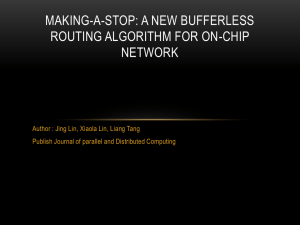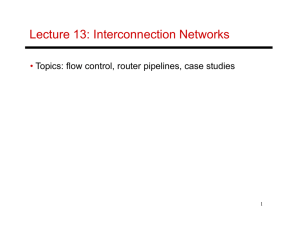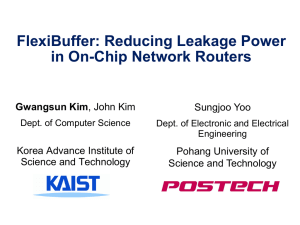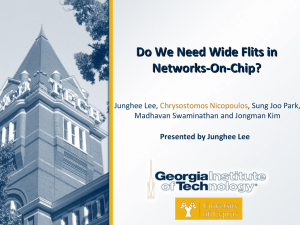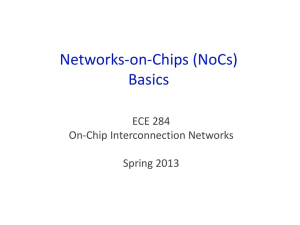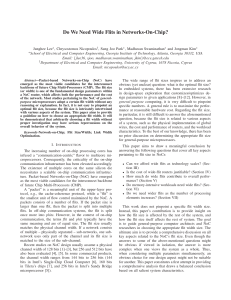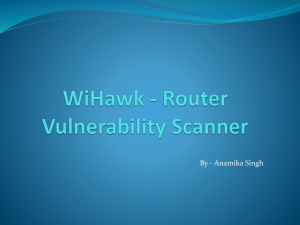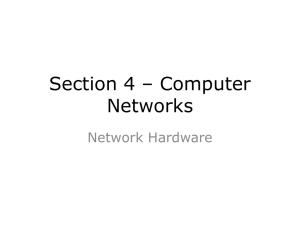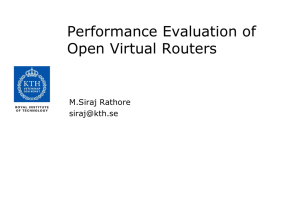Network-on-Chip Architectures and Building Blocks
advertisement
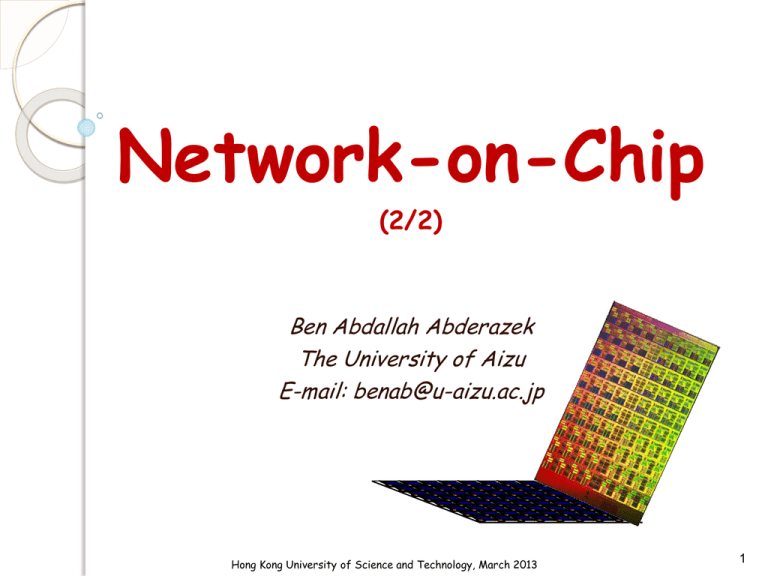
Network-on-Chip (2/2) Ben Abdallah Abderazek The University of Aizu E-mail: benab@u-aizu.ac.jp Hong Kong University of Science and Technology, March 2013 1 Part II: NoC Building Blocks Topology Routing Algorithms Routing Mechanisms Switching Flow Control Router Architecture Network Interface 2 Part II: NoC Building Blocks Topology Routing Algorithms Routing Mechanisms Switching Flow Control Router Architecture Network Interface 3 NoC Switching Switching techniques define the way and time of connections between input and output ports inside a switch. Circuit switched networks reserve a physical path before transmitting the data packets Packet switched networks transmit the packets without reserving the entire path. 4 Circuit Switching Header Probe Acknowledgment Data ts Link tr ts tsetup tdata Time Busy Hardware path setup by a routing header or probe End-to-end acknowledgment initiates transfer at full hardware bandwidth 6 Circuit Switching Example 0 Configuration Probe 5 Data Circuit Acknowledgement Significant latency overhead prior to data transfer Other requests forced to wait for resources 7 Store & Forward Switching Source node Intermediate nodes Destination node Each node along a route waits until a packet is completely received (stored) and then the packet is forwarded to the next node Two resources are needed Packet-sized buffer in the switch Exclusive use of the outgoing channel 9 Store & Forward Switching Example High per-hop latency Larger buffering required 11 Store & Forward Switching Advantage While waiting to acquire resources, no channels are being held idle Disadvantage Requires a large amount of buffer space at each node Very high latency 12 Virtual Cut-through Switching Transmission on the next channel starts directly when the new header flit is received Channel is released after tail flit 14 Virtual Cut-through Switching Transmission on the next channel starts directly when the new header flit is received Channel is released after tail flit 15 Virtual Cut-through Switching Transmission on the next channel starts directly when the new header flit is received Channel is released after tail flit 16 Virtual Cut-through Switching Transmission on the next channel starts directly when the new header flit is received Channel is released after tail flit 17 Virtual Cut-through Switching Example 0 5 Lower per-hop latency Larger buffering required 20 Wormhole Switching Source node Intermediate nodes Destination node Large packets are divided into small flits An entire packet need not be buffered to move on to the next node, increasing throughput. More efficient use of buffers than virtual cut-through Bandwidth and Channel allocation are decoupled 21 Wormhole Switching Source node Intermediate nodes Destination node Large packets are divided into small flits An entire packet need not be buffered to move on to the next node, increasing throughput. More efficient use of buffers than virtual cut-through Bandwidth and Channel allocation are decoupled 22 Wormhole Switching Source node Intermediate nodes Destination node Large packets are divided into small flits An entire packet need not be buffered to move on to the next node, increasing throughput. More efficient use of buffers than virtual cut-through Bandwidth and Channel allocation are decoupled 23 Wormhole Switching Source node Intermediate nodes Destination node Large packets are divided into small flits An entire packet need not be buffered to move on to the next node, increasing throughput. More efficient use of buffers than virtual cut-through Bandwidth and Channel allocation are decoupled 24 Wormhole Switching Header Flit Link Single Flit tr ts twormhole Time Busy Message are pipelined, but buffer space is on the order of a few flits Small buffers + message pipelining small compact switches/routers Messages cannot be interleaved over a channel: routing information is only associated with the header 25 Wormhole Example Red holds this channel: channel remains idle until read proceeds Channel idle but red packet blocked behind blue Buffer full: blue cannot proceed Blocked by other packets 6 flit buffers/input port 26 Virtual Channel Virtual channels used to combat HOL block in wormhole Virtual channels: multiple flit queues per input port Share same physical link (channel) Link utilization improved Flits on different VC can pass blocked packet 27 Virtual Channel Example Buffer full: blue cannot proceed Blocked by other packets 6 flit buffers/input port 3 flit buffers/VC 28 Virtual Channel Example A: active W: waiting I: idle hold information about which output virtual channel we are attempting to acquire hold information about which input VC it is reserved by 29 A Virtual Channel Router 30 A Virtual Channel Router Every VC of every input port has buffers to hold arriving flits Arriving flits are placed into the buffers of corresponding VC 31 A Virtual Channel Router Every VC of every input port has buffers to hold arriving flits Routing logic assigns set of outgoing VC on which flit can go Arbitrates between competing input VC & allocates output VC Arriving flits are placed into the buffers of corresponding VC 32 A Virtual Channel Router Every VC of every input port has buffers to hold arriving flits Routing logic assigns set of outgoing VC on which flit can go Arbitrates between competing input VC & allocates output VC Arriving flits are placed into the buffers of corresponding VC Matches successful input ports (allocated VC) to output ports Flits at input VCs getting grants are passed to output VCs 33 VC Arbitration: Fair Bandwidth The virtual channels interleave their flits This results in a high average latency 34 VC Arbitration: Winner-Take-All A winner-take all arbitration reduces the average latency with no throughput penalty 35 Summary of Switching Techniques Switching Technique Communication Entity Path Reservation Buffer Size Resource Utilization Circuit Switching Flit Yes Small Poor SAF Switching Packer No Large Good VCT Switching Packet No Large Good Wormhole Switching Flit Yes Small Moderate Summary of switching techniques 42 Break + Qs 43 Part II: NoC Building Blocks Topology Routing Algorithms Routing Mechanisms Switching Flow Control Router Architecture Network Interface 44 Flow Control (FC) FC determines (1) how resources (Buffers and channel bandwidth) are allocated and (2) how packet collisions over resources are resolved. Goal is to use resources as efficient as possible to allow a high throughput A resource collision occurs when a packet P is unable to proceed because some resource it needs is held by another packet. 45 Node Resources 1. Control State Tracks the resources allocated to the packet in the node and the state of the packet 2. Buffer Packet is stored in a buffer before it is send to next node 3. Bandwidth To travel to the next node bandwidth has to be allocated for the packet 46 Flow Control NoC Flow Control can be divided into: 1. Bufferless flow control Packets are either dropped or misrouted 2.Buffered flow control (covered here) Packets that cannot be routed via the desired channel are stored in buffers Stop-Go, ACK/NACK, Credit-Based 47 Bufferless flow Control Flits can’t wait in routers. Contention is handled by: contention ◦ Dropping and retransmitting from the source. ◦ Deflecting to a free output. 48 Bufferless Flow Control No buffers mean less implementation cost If more than one packet shall be routed to the same output, one has to be Misrouted or Dropped Example: 2 packets A and B (consisting of several flits) arrive at a network node 49 Bufferless Flow Control Packet B is dropped and must be resended But, there must be a protocol that informs the sending node that the packet has been dropped Example: Resend after no ACK has been received within a given time 50 Bufferless Flow Control Packet B is misrouted No further action is required here, but at the receiving node packets have to be sorted into original order 51 Stop-Go Flow Control sender receiver X pipelined transfer GO GO threshold Receiver sends Issues a STOP signal when STOP threshold is reached STOP threshold Sender sends Sender suspends packets whenever injecting flits GO signal is idle X Queue is not serviced STOP © T.M. Pinkston, J. Duato, with major contributions by J. Filch 52 Stop-Go Flow Control sender receiver X pipelined transfer GO GO threshold Receiver sends Issues a GO signal when GO threshold is reached STOP threshold Sender suspends Sender sendingresumes packets injecting STOP flits whenever signal is idle X Queue is not serviced STOP © T.M. Pinkston, J. Duato, with major contributions by J. Filch 53 Ack/Nack Flow Control Upstream node sends packets without knowing, if there are free buffers in the downstream node. 54 Ack/Nack Flow Control If there is no buffer available: the downstream node sends Nack and drops the flit the flit must be resent flits must be reordered at the downstream node If there is a buffer available: the downstream node sends Ack and stores the flit in a buffer 55 ACK/NACK Transmission ACK and buffering NACK ACK/NACK propagation Memory deallocation Retransmission Go-back-N 56 Credit-Based Flow Control Upstream router stores credit counts for each downstream VC Upstream router When flit forwarded Decrement credit count Count == 0, buffer full, stop sending Downstream router When flit forwarded and buffer freed Send credit to upstream router Upstream increments credit count 57 Credit Timeline Node 1 Node 2 t1 t2 Flit departs router Process Credit round trip delay t3 t4 Process t5 Round-trip credit delay: Time between when buffer empties and when next flit can be processed from that buffer entry If only single entry buffer, would result in significant throughput degradation Important to size buffers to tolerate credit turn-around 58 Credit-Based Flow Control in action Sender sends packets whenever credit counter is not zero sender Credit counter receiver 10 0 1 2 3 4 5 6 7 8 9 X pipelined transfer Queue is not serviced © T.M. Pinkston, J. Duato, with major contributions by J. Filch 59 Credit-Based Flow Control in action Receiver sends credits after they become available Sender resumes injection sender Credit counter receiver 10 6 7 8 9 2 3 4 5 0 1 +5 X pipelined transfer Queue is not serviced 60 On-Off (stall-go) Flow Control Credit: requires upstream signaling for every flit On-off: decreases upstream signaling Off signal Sent when number of free buffers falls below threshold Foff On signal Send when number of free buffers rises above threshold Fon 61 On-Off Timeline Node 1 Node 2 t1 Foffset to prevent flits arriving before t4 from overflowing t2 t3 t4 Proces s Fonthreshold reached t5 Fonset so that Node 2 does not run out of flits between t5 and t8 Foffthreshold reached t6 t7 Proces s t8 Less signaling but more buffering On-chip buffers more expensive than wires 62 Summary of FC On-chip networks require techniques with lower buffering requirements Wormhole or Virtual Channel flow control Dropping packets unacceptable in onchip environment Complexity of flow control impacts router microarchitecture 63 Summary of FC Ack/Nack: is rarely used because of its buffer and bandwidth inefficiency. Credit-based: Used in systems with small numbers of buffers. On/Off : Used in systems that have large numbers of flit buffers. 64 Part II: NoC Building Blocks Topology Routing Switching Virtual Channels Flow Control Router Architecture Network Interface 65 Typical Virtual Channel Router A router functional blocks can be divided into: 1. Data path: handles storage and movement of a packets payload Input buffers , Switch, Output buffers 2. Control path: coordinating the movements of the packets through the resources of the datapath Route Computation, VC Allocator, Switch Allocator 66 Typical Virtual Channel Router The input unit contains a set of flit buffers Maintains the state for each virtual channel G = Global State R = Route O = Output VC P = Pointers C = Credits 67 Virtual Channel State Fields (Input) 68 Virtual Channel State Fields (Output) 69 Packet Rate and Flit Rate The control of the router operates at two distinct frequencies Packet Rate (performed once per packet) Route computation Virtual-channel allocation Flit Rate (performed once per flit) Switch allocation Pointer and credit count update 70 The Router Pipeline No pipeline stalls 71 The Router Pipeline A typical router pipeline includes the following stages: RC (Routing Computation) VC (Virtual Channel Allocation) SA (Switch Allocation) ST (Switch Traversal 72 The Router Pipeline Cycle 0 Head flit arrives and the packet is directed to an virtual channel of the input port (G = I) no pipeline stalls 73 The Router Pipeline Cycle 1 Routing computation Virtual channel state changes to routing (G = R) no pipeline stalls Head flit enters RC-stage First body flit arrives at router 74 The Router Pipeline Cycle 2: Virtual Channel Allocation Route field (R) of virtual channel is updated Virtual channel state is set to “waiting for output virtual channel” (G = V) no pipeline stalls Head flit enters VA state First body flit enters RC stage Second body flit arrives at router 75 The Router Pipeline no pipeline stalls Cycle 2: Virtual Channel Allocation The result of the routing computation is input to the virtual channel allocator If successful, the allocator assigns a single output virtual channel The state of the virtual channel is set to active (G =A 76 The Router Pipeline no pipeline stalls Cycle 3: Switch Allocation All further processing is done on a flit base Head flit enters SA stage Any active VA (G = A) that contains buffered flits (indicated by P) and has downstream buffers available (C > 0) bids for a single-flit time slot through the switch from its input VC to the output 77 VC The Router Pipeline Cycle 3: Switch Allocation If successful, pointer field is updated Credit field is decremented no pipeline stalls 78 The Router Pipeline no pipeline stalls Cycle 4: Switch Traversal Head flit traverses the switch Cycle 5: Head flit starts traversing the channel to the next router 79 The Router Pipeline Cycle 7: Tail traverses the switch Output VC set to idle Input VC set to idle (G = no pipeline stalls I), if buffer is empty Input VC set to routing (G = R), if another head flit is in the buffer 80 The Router Pipeline no pipeline stalls Only the head flits enter the RC and VC stages The body and tail flits are stored in the flit buffers until they can enter the SA stage 81 Pipeline Stalls Pipeline stalls can be divided into: Packet stalls can occur if the virtual channel cannot advance to its R, V, or A state Flit stalls If a virtual channel is in active state and the flit cannot successfully complete switch allocation due to Lack of flit, Lack of credit, Losing arbitration for the switch time slot 82 Example for Packet Stall 1. Virtual-channel allocation stall Head flit of A can first enter the VA stage when the tail flit of packet B completes switch allocation and releases the virtual channel 83 Example for Flit Stalls 2. Switch allocation stall Second body flit fails to allocate the requested connection in cycle 5 84 Example for Flit Stalls 3. Buffer empty stall Body flit 2 is delayed three cycles. However, since it does not have to enter the RC and VA stage the output is only delayed one cycle! 85 Part II: NoC Building Blocks Topology Routing Switching Virtual Channels Flow Control Router Architecture Network Interface 86 Network Interface Transmitter side Core Memory NI NI Router Router 87 Network Interface Core NI Router Flit type Destination stw r9, 0(r10) stw r9, 0(r10) SourceP# PS Flitization Packet # S D FT Packet size 88 Network Interface Core Router NI stw r9, 0(r10) PS P# S D FT 89 Network Interface Receiver side Core Memory NI NI Flit Router Router 90 Network Interface Router NI Memory FT stw r9, 0(r10) Delitization 91 Network Interface Router NI Memory stw r9, 0(r10) 92 Network Interface End Body Header Payload Source Dest End Body Flit Type Header Payload Source Dest Flit Type OASIS NoC NI 93 Summary NoC is a scalable platform for billion-transistor chips. Several driving forces behind it. Telecommunication devices, embedded and GP domains are attractive applications for NoC. Expected to change the way we structure and model VLSI systems. Many open research questions. 94 References OASIS2 NoC Chip Akram Ben Ahmed, Shohei Miura, A. Ben Abdallah, Run-Time Monitoring Mechanism for Efficient Design of Network-on-Chip Architectures, to appear in the 6th International Workshop on Engineering Parallel and Multicore Systems (ePaMuS2013'), July 2013. Akram Ben Ahmed, A. Ben Abdallah, Low-overhead Routing Algorithm for 3D Network-on-Chip, IEEE Proc. of the The Third International Conference on Networking and Computing (ICNC'12), pp. 23-32, 2012. Akram Ben Ahmed, A. Ben Abdallah, LA-XYZ: Low Latency, High Throughput Look-Ahead Routing Algorithm for 3D Network-on-Chip (3D-NoC) Architecture, IEEE Proceedings of the 6th International Symposium on Embedded Multicore SoCs (MCSoC-12), pp. 167-174, 2012. Akram Ben Ahmed, A. Ben Abdallah, ONoC-SPL Customized Network-on-Chip (NoC) Architecture and Prototyping for Data-intensive Computation Applications, IEEE Proceedings of The 4th International Conference on Awareness Science and Technology, pp. 257-262, 2012. A. Ben Ahmed, A. Ben Abdallah, Efficient Look-Ahead Routing Algorithm for 3D Network-on-Chip (3D-NoC),IEEE Proceedings of the 6th International Symposium on Embedded Multicore SoCs (MCSoC-12,) pp. 167-174,2012. R. Okada, Architecture and Design of Core Network Interface for Distributed Routing in OASIS NoC, Technical Report, ASL- Parallel Architecture Group, School of Computer Science and Engineering, The University of Aizu, March 2012. A. Ben Ahmed, A. Ben Abdallah, K. Kuroda,Architecture and Design of Efficient 3D Network-on-Chip (3D NoC) for Custom Multicore SoC, IEEE Proc. of the 5th International Conference on Broadband, Wireless Computing, Communication and Applications (BWCCA-2010), pp.67-73, Nov. 2010. (best paper award) (slides) K. Mori, A. Esch, A. Ben Abdallah, K. Kuroda, Advanced Design Issues for OASIS Network-on-Chip Architecture, IEEE Proc. of the 5th International Conference on Broadband, Wireless Computing, Communication and Applications (BWCCA-2010),pp.74-79, Nov. 2010. slides T. Uesaka, OASIS NoC Topology Optimization with Short-Path Link, Technical Report, Systems Architecture Group,March 2011 K. Mori, A. Ben Abdallah, OASIS NoC Architecture Design in Verilog HDL, Technical Report,TR-062010-OASIS, Adaptive Systems Laboratory, the University of Aizu, June 2010. slides Shohei Miura, Abderazek Ben Abdallah, Kenichi Kuroda, PNoC: Design and Preliminary Evaluation of a Parameterizable NoC for MCSoC Generation and Design Space Exploration, The 19th Intelligent System Symposium (FAN 2009), pp.314-317, Sep.2009. Kenichi Mori, Abderazek Ben Abdallah, Kenichi Kuroda, Design and Evaluation of a Complexity Effective Network-on-Chip Architecture on FPGA, The 19th Intelligent System Symposium (FAN 2009), pp.318-321, Sep. 2009. A. Ben Abdallah, T. Yoshinaga and M. Sowa, "Mathematical Model for Multiobjective Synthesis of NoC Architectures", IEEE Proc. of the 36th International Conference on Parallel Processing, Sept. 4-8, 2007. A. Ben Abdallah, Masahiro Sowa, "Basic Network-on-Chip Interconnection for Future Gigascale MCSoCs Applications: Communication and Computation Orthogonalization", JASSST2006, Dec. 4-9th, 2006. 1. Book: Multicore Systems-on-Chip: Practical Hardware/Software Design, 2nd Edition, Author: A. Ben Abdallah, Publisher: Springer, (2013) , ISBN-13: 978-9491216916. [Amazon] 95
